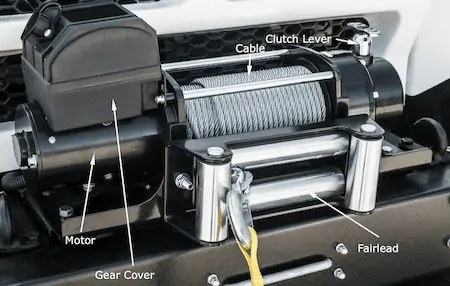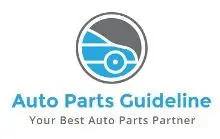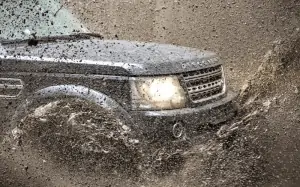Winches are essential and beneficial devices when you are going on an off-roading adventure.
Driving through rough terrain means, you will most probably come across muddy ditches, swamps, and other road traps where your vehicle can get stuck at any time.
Having a winch right that moment comes in handy and saves you from danger.
Different vehicles and different tasks require the use of different types of winches.
This is why understanding a winch and its parts will always help you when figuring out which winch-type is the best for you.
Continue reading to find out more about parts of a winch.
Important Parts Of A Winch

A winch is made out of several components. With the understanding of the different components, you can determine which winch is of the best use to you.
Every vehicle owner requires a specific type of winch for their specific towing needs, and each winch serves differently and with a variation to the others.
Learning about different parts of a winch can make you a better judge of winches and understand which one you need for your specific task.
#1. Motor
There are two types of motors that winches use, Series Wound Motors and Permanent Magnet Motors.
These motors are DC motors, and they come with either a set of permanent magnets or coils known as the stator, which is inside of the armature, another set of coils.
The main job of the stator is to produce a magnetic field to rotate the armature (or the rotor) when an electric current is to flow through it.
The motion is caused by a voltage being applied to the coils, which helps to produce torque in the armature.
As most people can tell, the types of motors with more power and torque will be rated to have more horsepower.
The combination of the gear train gear and the motor torque ratio reduction is responsible for the winch’s rating.
The horsepower of the motor directly affects the pulling power and the line speed of the winch.
i. Series Wound Motors
In a Series Wound Motor, the field coils are all connected to the armature coil with a series connection.
If you are looking for something that provides you with efficiency at high speeds and offers power while generating as much torque as it can give the current, then series-wound motors are the way to go.
Since a series wound motor uses field coils to generate a magnetic field, they tend to be using a lot more current when compared to a permanent magnet motor.
Winches that use series-wound motors often tend to be more on the expensive side since they are the best option to go with for heavy-duty tasks.
A permanent magnet motor can pull about the same as a series wound motor, drawing a lesser amperage from the charging system and the battery.
However, with the permanent magnetic motor, the increase in amperage draw will decrease the power.
This is because the permanent magnet motor tends to run warm. For a series wound motor, throughout the whole cycle, the draw of amperage remains the same.
ii. Permanent Magnet Motors
In a permanent magnet motor, there are no field coils. Instead, the stator makes use of permanent magnets.
Compared to the series wound motors with field coils in their stators, permanent magnet motors offer less drain to your battery.
Since the permanent magnet motors tend to generate a lot of heat which causes them to overheat, they are more suited towards medium to light-duty winching.
Since these motors do tend to overheat, you must monitor the winching load and time carefully.
Permanent Magnet Motors provide more pulling power than Series Wound Motors and put less load on the battery.
These are also less expensive than Series Wound Motors in most cases. They are never as heat resistant as Series Wound Motors and the winching load and time must be carefully considered.
If you live in a very cold climate, you should avoid using a permanent magnet motor because it loses power at very cold temperatures.
Also, you should remember that since permanent magnet motors use magnets in their motors, they are likely to lose their field strength with repeated and continuous use.
#2. Gear System
The three most common gearing systems that you get with winches are spur gear, worm gear, and planetary gear.
The main job for all three of these gear systems is gearing down the higher-speed motors to a lower speed. The main difference between all three of these gearing systems is their ability to transfer efficiency.
The gear reduction ratio is the number of output revolutions by the motor reduced to the spindle.
The reduction is more significant when the motor has to work less for a revolution. This means the motor has to turn more revolutions for one revolution of the spindle.
i. Planetary Gears
These are likely the most common type of gears that you might come across. Planetary gears offer you both the smoothness of operation and the strength, all with good resistance for torque loads.
The planetary gears are set up with the sun gear or the central gear surrounded by other planet gears, and this entire setup is enclosed with a ring gear.
You should know that the torque transmission capability in a planetary gear system is higher when there are more planet gears in the system.
This also means that pulling of the winch will be more efficient if the system of the planetary stage is higher.
These gear systems need a braking mechanism since they tend to free the spool when they are loaded. These gear systems also come with an efficiency of 65%.
There are a bunch of advantages to using a planetary gear system. You get long service lives, higher stability, and they are also lighter in weight.
The disadvantages are that they tend to be more expensive and make a bit of a noise when they are being operated.
ii. Spur Gears
These gears are similar to the planetary gear systems in that they need a braking mechanism since they tend to free the spool when they are loaded. These gear systems offer you an efficiency of 75%.
One of the biggest drawbacks that you can have with spur gears is the noise. These gears tend to be quite noisy.
The individual teeth of the gears collide with each other with every turn. These collisions also tend to increase the stress that is on the teeth.
Even though these gears have a low amperage draw, they are still quite fast.
iii. Worm Gears
The worm gears are all self-braking since they come with an efficiency of around 35 to 40%.
These gears, even under heavy loads, can be self-braking. However, this also means that they need to have a clutch mechanism to free these gears from spooling.
Even though you get slower winching speeds with worm gears, you still get a built-in braking system, excellent reliability, and the most reduction.
Since you get the most possible gear reductions and there is no need for a braking system, the worm drives are usually simpler and more robust than most other gear systems out there, for example, the planetary gear system.
The worm gear winches are not typically seen in off-road situations. They are primarily used for industrial purposes. Some of the unique features that these gears have are load holding and lowering capabilities.
Another exceptional feature about this gear is that while the gear cannot turn the worm, the worm can very well turn the gear, which comes especially in handy when you are hosting.
With this gear, the chances of your load crashing tend to be very minimal if the power were to fail mid-operation.
The main drawback that you face with worm gears is that they come with quite a noticeable reduction in the line speed.
This is more evident when the cable is being reeled up with no load. In these situations, the planetary gear systems are the ones that have the most advantage.
#3. Winch Solenoids
If you are not sure what winch solenoids are, then they are just electromagnetic switches. When the remote switches send electricity to the solenoid, a magnetic field is formed.
When this happens, the winch’s circuit is complete, and then depending on which of the solenoids were activated, the winch motor moves either backward or forward.
Two Or Four Solenoids?
Some winches come with two solenoids, while others come with four. The configuration of two solenoids is generally found in the permanent magnet motor winches. They tend to be less robust, less reliable, heavier, and also cheaper.
The winches that come with the four solenoid configurations are the ones that use a series wound motor.
This is because they tend to be a lot lighter, stronger, and of course, more reliable.
#4. Winch Drum
Winches are heavy-duty devices that operate by wrapping a lengthy rope around a cylindrical drum. A winch drum is an essential component of a winching system.
A motor that can rotate the drum in either direction is typically used to drive it, allowing the cable to be fed out or withdrawn inward.
The winch drum’s size is determined by the total size of the winch system and the individual cable, and it can be manually turned or motorized.
Based on the purpose of the winch system, materials that are used to make the drum may also vary.
#5. Winch Cable
Cables are one of the most vital parts of a winch. Traditionally, steel winch cable and synthetic ropes are used as winch cables.
Steel cables are strong and durable. But, they’re quite heavy and can get damaged with rust. Synthetic ropes are lightweight but aren’t as durable as steel cables.
So, you have to make your pick depending on your requirements and the vehicle you have.
#6. Winch Fairleads
A fairlead’s main purpose is to prevent the winch line from fraying or being damaged while the winch is in use.
The fairlead is normally situated in front of the winch, in or on the bumper. If you don’t have a fairlead on your winch line, it won’t last long.
Without a fairlead, the winch line would snag on the sharp edges of your bumper, inflicting substantial wear and strain on the line.
Fairleads come in a number of shapes and sizes, but choosing the right one for you is crucial.
As most winching is done at an angle, having a fairlead with an appropriate surface area to protect and preserve your winch line is essential.
#7. Free-Spool Clutch
A clutch is an essential part of a winch that comes into play, especially during free spooling.
It is placed on the side of the drum. The clutch detaches the drum from the gear, allowing it to revolve freely for free spooling.
The clutch engages, “blocking” the winch drum and returning it to the gear train. Because of an engaged clutch, the cable will not be released during operation.
#8. Winch Batteries
There are times when there are two batteries needed to operate a winch.
To find out whether one battery is enough for your winch or not, you should check the information on the voltage rating and amp for your winch. Ensure that the electrical connections are all tight and clean.
Your battery is likely to be draining faster than it can charge if the ORV engine tends to idle when you’re winching.
Always check the voltage gauge carefully to ensure that the battery has enough power to start up the ORV engine.
#9. The Diameter Of The Winch’s Spool
The pulling power and the line speed of the winch are directly affected by the diameter of the Drum and Gear Ratio.
The unavoidable loss of the pulling power when the cable is spooling in is determined by the drum’s width.
The effective gear ratio will drop and thus reduce the pulling power of the winch if there is an increase in the layers of the drum.
The cable spools up a lot quicker if the drum is on the narrower side. However, this does mean that compared to a broader drum, this tends to lose its pulling power a lot quicker.
This is why depending on the type of work you are doing with your winch, you need to select a winch with the proper spool diameter.
Final Words
All of the parts of a winch that we talked about here are the major components for building a winch.
The unique contributions of these parts to the machine have a significant impact on the winch’s efficiency, reliability, and power. So, all of these parts need to work just as they should.
Check these parts if you’re thinking about buying a winch, you might save a lot of money in the long run.
We hope this helped you understand the parts of a winch and know which type of winch works best for you!



![Read more about the article How To Wire A Winch Without A Solenoid? [Step By Step Guide]](https://autopartsguideline.com/wp-content/uploads/2022/05/how-to-wire-a-winch-without-solenoid-300x184.webp)